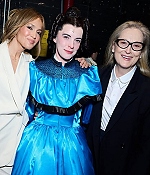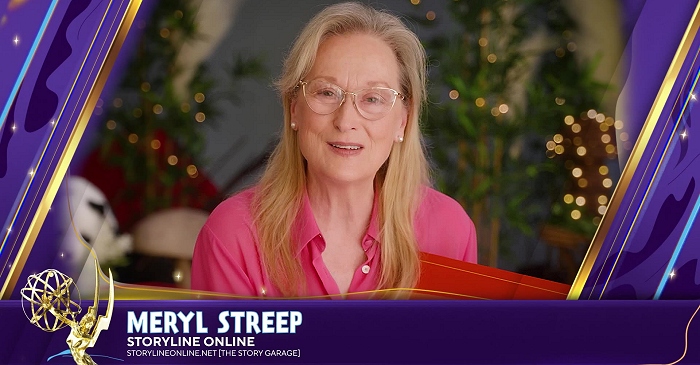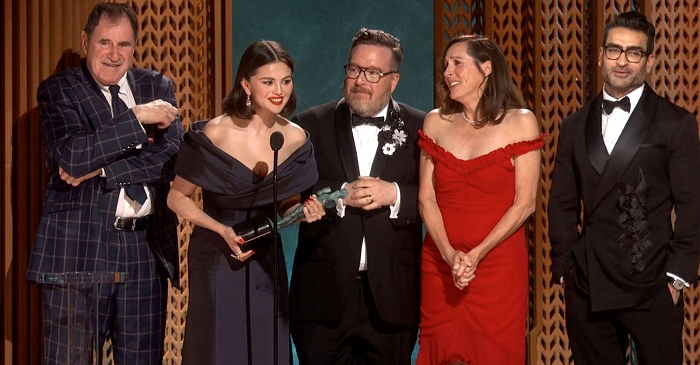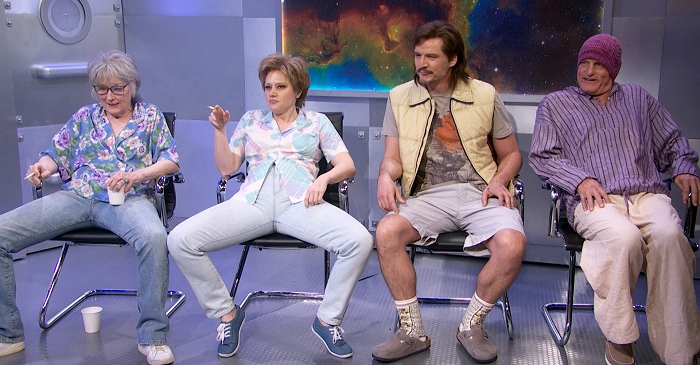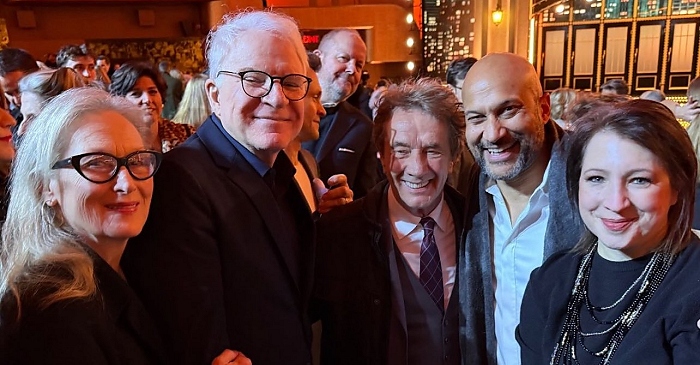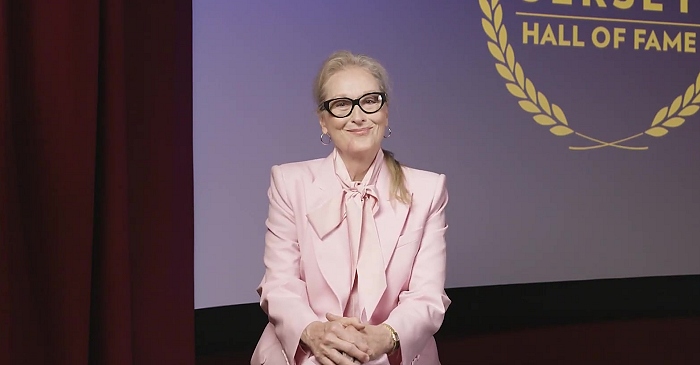|
Simply Streep is your premiere source on Meryl Streep's work on film, television and in the theatre - a career that has won her the praise to be one of the world's greatest working actresses. Created in 1999, we have built an extensive collection to discover Miss Streep's body of work through articles, photos and videos. Enjoy your stay.
|
Celebrating
25 years
of SimplyStreep
|
|
Meryl the Mom - in Life and on Film
The Boston Globe ·
January 10, 1997
· Written by Matthew Gilbert
|
Boldly, Meryl Streep hoists her feet onto the coffee table’s edge. “Only because it’s not my living room,” she says wryly, looking around her in case there are stray children hiding under the couch. She’s in “Connecticut Mom” mode, this great Hollywood actress, and with her smart green blazer, pearl necklace and sensible haircut, she does look like she’s en route to a PTA gathering. Today, in a hotel beside the Colorado River, Streep could be an out-and-out soccer mom, minivan with kids waiting outside, an undone load of laundry with her name on it at home. No Hollywood glamour items on the list of errands. Surprised? What does one expect of Streep, anyway? Since 1977, with her debut in “Julia,” public images of the actress have come from her movie roles, and not through the celebrity and tabloid presses. It’s easier to imagine Streep as the fragile Sophie of “Sophie’s Choice” or the brittle Lindy Chamberlain of “A Cry in the Dark” than to imagine Streep as Streep, Mrs. Don Gummer as she sometimes calls herself. “I don’t go anywhere,” she says half-apologetically. “You have to go to openings and be on E! Entertainment, and I’ve never enjoyed doing that. . . . It poses a problem marketing a movie, because they want you out and about. So it’s always a tug, it’s always a battle with the guilt-making machinery.” This month, Streep is conceding to the “guilt-making machinery” to promote “Marvin’s Room,” a comic-dramatic piece about family estrangement and illness, with Diane Keaton, Leonardo DiCaprio and Robert De Niro.
The film is a reminder of Streep’s rededication to serious acting after an awkward light period that began with “She-Devil” in 1989 and culminated with the thriller “The River Wild” in 1994. She dislikes interviews-“I always feel like, who am I to pontificate, barking on and on?”-but she has flown to Texas, leaving her four children at their 89-acre estate in northwestern Connecticut, to meet the press and bark. “My problem as a stressed-out ’90s mother and career person is that I don’t have time to think about what I think about,” she says. “I operate by the seat of my pants.
“And at home, my kids don’t want to know what I think of anything! Certainly not what I think of ‘The State of the Movies’ or ‘Women in Film.’ ” Streep adds an exaggerated highfalutin tone to her last two phrases. During the course of the day, Streep repeatedly returns to the subject of her role as mother. “I sacrifice for family, endlessly,” she says. “Every single decision I make about what material I do, what I’m putting out in the world, is because of my children.” Despite her huge professional success, she says, she has always visualized herself as a mother first. “I was never the kind of person who said, ‘I’m going to be an actress. And if I meet somebody and have a family, great.’ I always, always, since I was a little girl, wanted to have kids and a family. I just had to wait 30 years to find somebody I liked enough.” She found Don Gummer, a sculptor, whom she married in 1978.
When choosing roles, she accepts those that enable her to be near her children-Henry, 17; Mary Willa, 13; Grace, 10; and Louisa, 5. “How often do you imagine I’m home? I’m home aaaaa-lot! I don’t go on location anymore.” For “Marvin’s Room,” which filmed in Manhattan, she took a daily helicopter from Connecticut. “I got very pissy at the end of the day,” she says, “if people weren’t hustling their butts to finish their work so I could get in the helicopter.” Streep says motherhood determines not only where but what she’ll act. She’s acutely conscious of the effects of pop culture on children. “I don’t have a cynical point of view on the movie business,” she says. “I feel that everything signifies. Everything counts that we put out in my business. It all leaves an imprint on kids who are way too young to be looking at the crap-the stuff-that’s out there. . . . Do I want them to page through Vogue and see the Nan Goldin models and the heroin look? Or the Calvin Klein downtown porn thing? Is that cool? That’s not cool to me, I don’t like it. . . . “There are great roles for young women in films, but usually they are hookers who get sodomized. And my kids want to see the thing that they perceive as tough and edgy because edgy is the adjective of the day. All it means to me is depressing. And as a parent, you don’t want to see your kids go to that. You want them to embrace life and see the possibilities and the optimism. You just do.”
She laughs. “I’m getting very much to be a curmudgeon in my old age! I’m mad about everything!” The two female leads in “Marvin’s Room,” based on a 1991 play by the late Scott McPherson, are both juicy, and quite different. Selfless Bessie has stayed at home in Florida to care for her aunt and her near-comatose father. The younger Lee, a beautician, moved to Ohio to escape the suffering. Now that Bessie has leukemia, Lee returns to Florida with her two sons to donate bone marrow and reignite old battles. Streep initially signed on to play Bessie, but changed to Lee as the project, which was produced by De Niro, got closer to filming. “I had my choice, because”-she adopts a “na-na” tone-“I’m friends with Bob.”
Streep says she chose to play the less sympathetic sister because she’s more like Bessie: a caretaker. She conditioned her participation in “Marvin’s Room” on the casting of Keaton, she says. “If I gave up this gorgeous part, I wanted it to be somebody great. . . . And I wanted somebody I could feel like sisters with, because I never had a sister. So I picked my sister.” Keaton says she developed “kind of a crush” on Streep during the filming of “Marvin’s Room.” “When you look in Meryl’s face, you get lost in her eyes,” she says. “You get lost in her. And that’s a great thing. I find her beautiful, and I’m constantly looking at her.” One quality that distinguishes Streep’s body of work is her willingness to play flawed women like Lee in “Marvin’s Room.” She tends to choose characters who are troubled in a complex way-preoccupied with their needs (“Kramer vs. Kramer”), manipulative (“The French Lieutenant’s Woman”), tragically romantic (“Plenty”). She’s willing to go there, while other actresses might prefer more morally simplistic parts.
Streep has led a charmed acting life. After graduating from Vassar, she won a scholarship to Yale Drama School, where she attracted the attention of New York producers. After Yale, she landed at the New York Shakespeare Festival, and by 1977 she had a role in the movie “Julia.” A year later she was featured in “The Deer Hunter,” which brought her her first Oscar nomination, and in TV’s “Holocaust,” which brought her an Emmy. She then embarked on a series of prestigious movies that made her the most desirable actress of the 1980s. All told, she’s been nominated for 10 Oscars and won twice, for “Kramer vs. Kramer” and “Sophie’s Choice.” What could possibly motivate Streep as she enters her third decade in the movies? She sits back and pauses for a long moment. “I look for the thing that I got from it from the beginning. Because that’s the thing that intoxicates me. It’s what you get when you come upon a phrase in a poem that just goes through you. “How to describe that is really hard. It’s some recognition of the truth of life in that phrase or in that image or in that encounter. You feel it in pivotal moments in your life: when someone is born, when you fall in love, when someone dies, when someone tells a great joke and you haven’t laughed in a week and you just howl. The top flies off of your head. That’s what you look for. And that’s what happens in acting all the time, in moments. Surrounding that is a lot of police work, a lot of walking the beat and drudgery, but every once in a while, your adrenaline goes up. That’s the addictive thing.”

